Time Machine Through the Canal (Part I)
March 7th, 2007 by: cheyenneThe first morning of our canal transit (Feb. 25th), we were up and running around the boat at 5am, en route to Balboa by 6:30, had Jan and Richard from Slipaway as well as Cousin Tito aboard by 7:30 (Ben, just in from ice-floes-on-the-lake Chicago was also aboard), and were motoring around in circles waiting for the pilot boat by 8. Then they called us and told us that we were going to be cancelled. The lady at the bank who received our payment for the canal transit two weeks before had apparently gone on vacation and forgotten to turn in the correct form to wherever it was she needed to turn it in; rumor had it that there were three boats cancelled that day in addition to ours. Defeated for the time being, we anchored off Balboa and I fed our poor crew a consolation breakfast before dropping them all back off for another day (hopefully).
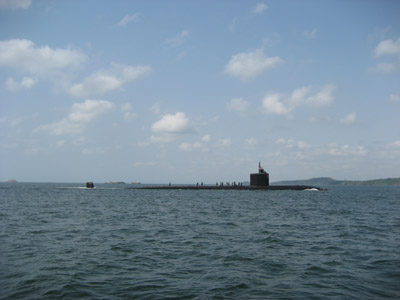
On our way back to the Playitas anchorage, where we had a lot of explaining to do, we passed a canal-bound US attack submarine whose paperwork was not misplaced by airheaded bank clerks.
On the second morning of our supposed canal transit, after having phoned the canal scheduling office repeatedly the previous day to confirm our transit (not that this made any difference the first time since we had then twice confirmed our transit and the scheduler had gone so far as to give us the name of our advisor as well as how we were to be configured inside the locks), we were up at 5am running around the boat. Cousin Tito had been able to get one workday off but with the rescheduling, two days off (in the event that we must stay overnight in Gatun Lake) was not possible and so we picked up Gary from “Sol Surfin,” who, as a warm body with a heartbeat, was happily recruited as our fourth line handler late the night before. Once more we were en route to Balboa to pick up Jan and Richard, and Joshua was on the VHF trying to reconfirm that we were indeed actually going to go through the canal this day, the 26th.
Success! Confirmation reconfirmed. We had a time and name, once more, of our advisor (“George”) and the pilot boat would come for us in one hour. We snagged a stray mooring at Balboa and had a shockingly similar breakfast to the one before. (Nobody complained.)
We were to go through with another sailboat, “Windrider,” who had rocketed down from San Diego over the past couple of months and was making a beeline to Florida where things would be more to their liking. They spoke zero Spanish and Joshua’s general impression from having chatted with them in the bank, canal office, dock, or wherever, was that they were somewhat clueless as to what was going on. In the world. They had actually hired an agent to line up their canal transit (not that it made any difference since they got bumped the previous day as well, and had to do all the bank/canal office/scheduling errands themselves) and they had four hired “professional” line handlers aboard.
At around 8:15 (right on time!), the pilot boat came and deposited George the Advisor onto our boat. We introduced ourselves and got him set up with a large mug of coffee (black, two sugars) while he started to poke around the outskirts of our boat. Joshua and I feigned nonchalance as we watched him stoop and finger our 3/4-inch lines and eye our wee little cleats (barely large enough to accommodate such a massive line but we were told over and over again that THOU SHALT HAVE 7/8-INCH LINES for the canal transit—a size that is dead-horse-flogging overkill for our little 3-ton boat). He wrapped the lines around the cleats and Joshua went to explain what we had set up in this regard.
The setup is as follows (here we have Richard the Line Handler demonstrating; you can vaguely see what is going on):
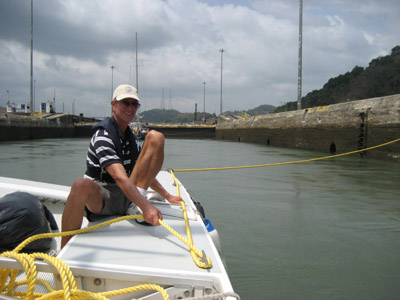
Joshua shackled large steel rings onto the chainplates at the extreme ends of the amas (the side thingies—pontoons) fore and aft and ran the lines through the rings down to the cleats located at the A-frames. The chainplates are extremely strong and would take the brunt of the force, the cleats would be used to lock off the ropes and work the lines, not as the main load-bearing component. Plus, with the cleats located more centrally, the line handlers would have a safer and more comfortable location to line-handle and would be less likely to fall overboard (not desirable). Joshua walked George through this and he seemed to think that the setup was good.
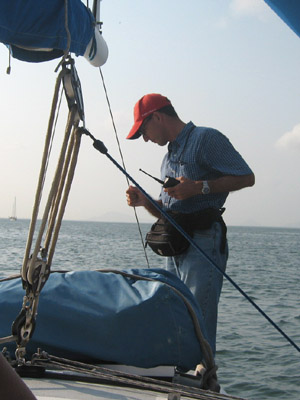
[George inspects the horses.]
Then he turned his attentions to our poor outboard. “Is this your only motor?” he asked. He eyed the outboard with incredible skepticism and leaned way out to try to see how many horses. Ironically, this is our new BIG outboard of fifteen bad ones and we had up until that point been feeling like hot shit. We explained that the boat was in fact very lightweight for a sailboat of its length and that fifteen horses was fully capable of pushing us. George furrowed his brow and gazed at the motor, then the boat, then the motor, and then the boat again. “How do you control it?” he asked. Um, well, that was why there were 6 of us aboard: one captain (“Skipper,” as George came to call Joshua), four line handlers, and one “engineer,” as George eventually named me—that is, after he was convinced, at least somewhat, that we weren’t all total nutballs and the motor did in fact move the boat. We chose to hold the interesting fact that we had come down from San Francisco with a mere 6 hp until later.
He had us drop the mooring and start an hour early for the motor up to the Miraflores entrance just in case our outboard couldn’t handle it. I took my place seated on the poop deck with my leg dangling over the stern and my hand on the control; Joshua directed me with hand signals since at the stern I couldn’t see much and could hear nothing but the motor. George kept wandering back and asking me what percentage throttle we were at. Now? How about now? He looked fairly chagrined at the scene but did not cancel us (he could call it off if he felt that our boat was not capable of getting through and he was such a stickler that we were almost worried that he might). We had of course put 8 knots down on the canal paperwork (8.5 actually, because, hell) and with 1/4 of the boat’s weight in humans aboard, a stiff 15-20 knots of wind gusting down the canal in our faces, and a couple of knots of current pouring out with the insane tides they have around here, we were going nowhere near 8 knots. More like 5 and the motor was at 75% throttle. I cranked the handle to full throttle to show him that the motor could in fact do more and George nearly had a heart attack, “NO! That’s okay! Don’t overdo it! We need that motor to get through the locks; don’t stress it too much! We don’t need to go fast right now.” He went back up to the cockpit where it was decidedly less exciting.
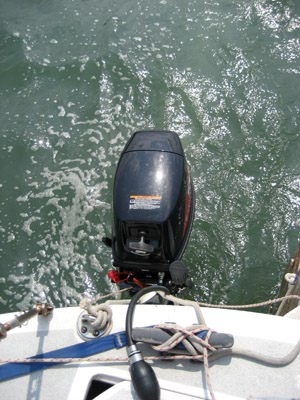
[My friend for the canal transit.]
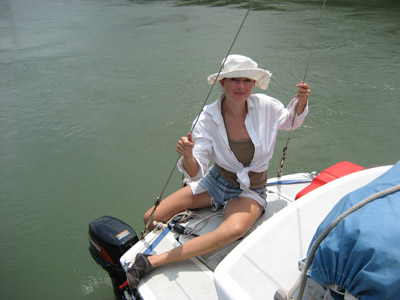
[My position for the canal transit, from which I was not to move until we were past Pedro Miguel.]
When we got to the Miraflores entrance, we motored around in circles waiting for our lock buddies (Windrider and a pilot boat). At 11:30 we entered the locks. We were tied alongside Windrider who was tied alongside the pilot boat who was tied to the wall. Once secured, the linehandlers had nothing to do but hang around taking photos. I had to stay at my post on the poop deck in case something should go wrong and I had to control the boat with the outboard; I not only controlled the throttle but had untied the outboard to have full steering capability as well. But nothing went wrong even with the flood turbulence and when we reached the top of the lock, we untied, backed up and held our position while Windrider and the pilot boat untied and moved out ahead of us into the second lock. This was not as straightforward as it sounds, actually, and we were flung around with the force of the propwash and freaky currents swirling around in the locks as soon as they moved. There was much gesturing and shouting at the engineer, who bore it stoically and managed to keep the Time Machine from dashing up against the walls thankyouverymuch. Once the other boats were secured in the second lock, we motored up and tied alongside once more.
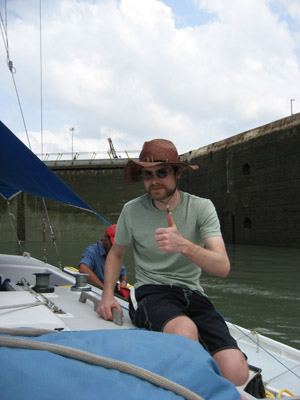
[Ben relays the message from Joshua; all systems looking good.]
Because the last undocking scene was a bit hairy, the advisors decided that once the lock was flooded and the doors opened, we would throw off Time Machine’s lines and crank the motor for all it was worth to get out of the locks ahead of the other boats. Unfortunately, Windrider’s “professional” line handlers just threw off our lines as soon as we reached the top of the lock even though the doors hadn’t even opened yet and when I saw this, I cranked the motor and steered us for the exit. Again, there was much shouting and gesturing at the engineer and I flipped the motor into hard reverse (we were right at the front of the lock to begin with and I couldn’t see what the doors were doing from my position on the stern). Then the doors opened and the swirling water spun us around sideways. Windrider and the pilot boat prudently chose this opportunity to untie and split. Meanwhile, we were sideways and heading at three knots for the back of the lock (current and major gusting wind); the line handlers were all clustered at the bow to push us off should we get too close to the wall but we managed to motor around back and forth until the bow was pointed once more for the Caribbean and we full throttled it out of the locks, waving and smiling at lock crew and cameras.
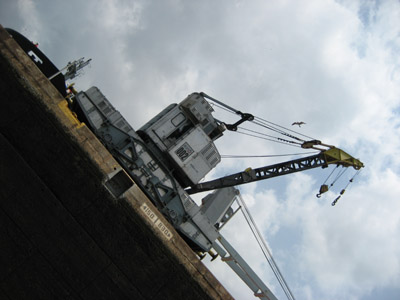
[Random lock scenery viewed from beneath; this is a crane.]
After a rapid motor across the tiny lake Miraflores, we had to mark time while waiting for the Pedro Miguel locks to be ready for us. Finally we entered, this time without the pilot boat and both of us center tied in the lock. This means that each sailboat was aligned singly in the lock with four lines to the walls on either side suspending it as the water rose. Our line handlers were going to earn their keep. As the water started swirling in, the boat lurched around a little but nothing out of the ordinary and the lines and handlers had everything under control. I had nothing to do but sit on the poop babysitting the idling motor and shout things at whoever was listening (nobody).
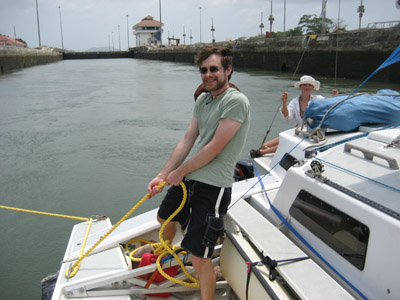
[Ben handling the lines.]

[More line-handling action from Jan.]
The lines were thrown down from the walls and pulled back up onto the boat and we motored out of the Pedro Miguel lock without incident. Finally I was relieved from motor duty and could join the rest of the crew in the cockpit where there was shade and audible conversation.
[I’ll get Part II up tomorrow!]


March 7th, 2007 at 3:50 pm
Hey! That was you guys I saw in the Miraflores webcam. I wasn’t sure because the time was later than you had originally estimated (a bit after noon) and there were two sailboats tied together, not just one. Sorry I wasn’t able to capture the image, you guys were out of the lock before I had everything set up. So welcome to our side of the Atlantic. Hope you have a great time.
Laszlo
March 8th, 2007 at 8:21 am
Wow—sounds harrowing and full of surprises. I didn’t realize that going up and down in the locks caused so much turbulence. In fact, while going through the 3 Gorges Dam in China, I don’t remember any “lines”. It felt like going up and down an elevator in each lock. Very fast, very smooth. I was in a small cruise ship (about 100 people). Thanks for the exciting story of your passage. I can’t wait for Part II. Love, Mom/Peg
March 8th, 2007 at 1:28 pm
Yay! I’m glad someone actually managed to spot us on the camera after all the delays. Did you see us flip around sideways? I think that may have made a good image. It was quite embarrassing.
c
March 9th, 2007 at 3:42 am
Luckily for your dignity, the camera has a slow refresh rate. All I saw were 2 frames with you guys in it and then you were gone. (I really did catch you at the last possbile moment.) Exciting transitions between the frames were left to the mind of the beholder. So if you hadn’t posted about the flipping around I would have never known. Your secret is safe :-)
Laszlo